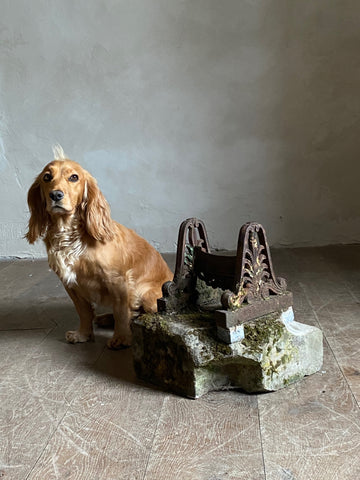The Boot Scraper - solving the mystery
Go to any town up and down the country and have a look at old houses on pretty much any street that takes your fancy, and you’ll notice certain features, the stone or brick they’re made from, the roof slates, the type of windows, doors and their furniture, the railings and gates and their exterior ornamentation.
But have you ever noticed recessed holes in a building’s façade, odd shapes in cast iron railings, odd lumps and bumps in pavement curbs or event flush metal stumps in your front step where something’s been cut away and wondered what on earth they are?
Then wonder no more, as we solve the mystery for you…
Throughout human history muddy byways and highways have always posed something of a problem (well actually often far worse than mud but we’re being polite…) it’s why the Romans built raised pavements with stepping stones connecting them so you could cross without disappearing for good or worse still end up stinking to high heaven from simply crossing the street!
And that certainly didn’t change until the turn of the 20th century and the invention of Tarmac by Edgar Hooley, who whilst visiting Denby, in Derbyshire, in 1901, noticed a smooth stretch of road surface close to an ironworks. Being quite a curious chap he asked locals what had happened, he was told a barrel of tar had fallen from a dray and split open. Someone had poured waste slag from the nearby furnaces over it to cover up the mess, But Hooley spotted that this unintentional mishap and subsequent clear up had solidified the road surface, with the result that there were no ruts, no dust and above all else no mud!
But until that time a trusty, though perhaps often overlooked item had performed something of an essential function since the beginning of the 18th century. Houses had them perched by their entrances, they could be found on street corners and were all the rage in public places… In their simplest form they were nothing more than a horizontal bar of cast iron, but many had much more complex forms, with designers incorporating centre pieces for scraping shoe soles, vertical elements for scraping the sides of boots and shoes and even curved angles for cleaning much off the heel of a shoe or boot.

The simple answer is the humble boot scraper. The French knew them for their literal function, decrottoir, the Spanish as raspador, and the Dutch as schraper – no doubt you get the general idea. These heavy, simply formed objects (though as mentioned some were amazingly elaborate), were a familiar sight the world over, from London to New York and Paris to Berlin and everywhere in between.

They were specifically designed to keep the level of mess brought into a building to a minimum, which given the state of streets back in the day must have been something of a nightmare. Boot scrapers came in three main forms: the free-standing type secured into the top of a step next to a door; portable scrapers, some even complete with side brushes; and built-in arched boot scrapers integrated into the fabric of a building, though most of these over time have since lost their cast iron cross bands.

Hundreds of shapes, were conceived, patents issued, and the proliferation continued unabated. That is until we revisit the work of that splendid fellow Hooley… you remember the gent who observed that accidental smooth surface near the Derbyshire smelting works involving chippings, slag and tar?

You see Hooley was highly astute, which is why in 1902 after observing the smooth piece of road surface set about patenting the idea of heating tar, adding slag and broken stones to form a mixture to create a smooth, yet sturdy surface. By 1903 he’d established a company called the Tar Macadam Syndicate Ltd and registered Tarmac as a trademark. He then perfected the manufacturing process and away you go Tarmac was born. But despite being astute Hooley was no businessman, however, Sir Alfred Hickman, a Wolverhampton MP, who also just happened to own a steel factory, which produce a huge quantity of slag saved the day and became involved, later forming the Tarmac company which still exists to this day. But sadly the wise adaptation of Tarmac almost immediately sounded the death knell for the boot scraper, with no more muddy mess they had become redundant and indeed many were seen as a public danger and were promptly removed, and if by some chance they did survive were later cut out and smelted down for use in war materials in both World Wars.


Leave a comment